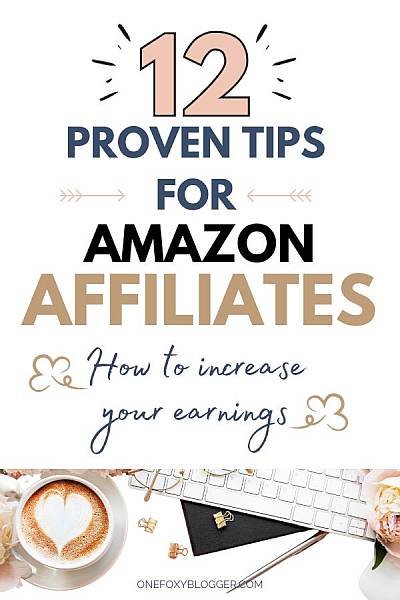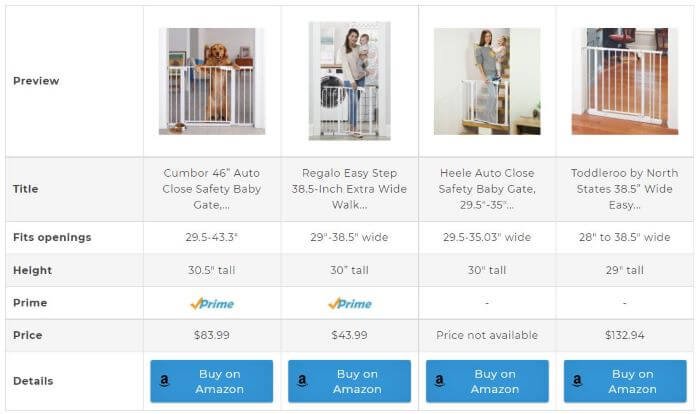12 Tried-and-True Methods for a Successful Amazon Affiliate Blog
This post may contain affiliate links. This means I get a commission if you purchase through my links at no extra cost. Read the full disclosure here.
Are you ready to earn money with your first Amazon affiliate blog post? Over the last 12 years, I have discovered several ways to promote Amazon products on my blogs, and I am ready to share them with you. With my Amazon affiliate marketing tips, you can easily monetize your blog and turn it into a thriving source of income. With Amazon’s affiliate program, you can generate steady income from the sales of products you recommend.

Amazon is among the best affiliate programs for bloggers, as there is something to promote in virtually every niche.
If you enjoy blogging and like recommending products, creating an Amazon affiliate blog can be an excellent way to monetize your interests.
Often, Amazon affiliates get discouraged when they don’t see immediate results. But, to succeed, you must have a solid plan to improve conversion rates.
Want to succeed at Amazon affiliate marketing??
Let me show you what I’ve learned and how to add Amazon affiliate links to your blog.
12 Never failing money-making tips for your new Amazon affiliate blog
1. In-text links
One of the most lucrative ways is simply adding a relevant link within the body text of your blog post. By creating high-quality blog posts that naturally incorporate Amazon affiliate blog links, you can provide value while earning commissions. Many affiliate marketers consider it the most effective method for people to click through to Amazon.
That doesn’t mean you should turn all possible keywords into affiliate links, as this will not seem like a genuine recommendation. Above all, your intention should be to offer value to your readers and that you’re not only in it for the money.
2. Choose best-converting products
Once visitors visit Amazon through one of your links, you want them to buy the product. Fortunately, Amazon makes it easy to select the best product to promote. Here are some tips for finding profitable Amazon affiliate products to promote:
- Amazon Best Sellers Page: Visit the Amazon Best Sellers page to see a constantly updated list of the top-selling products across various categories. This page provides insight into what is currently trending.
- Amazon Movers and Shakers: Check the Movers and Shakers list, which showcases products that have recently seen a significant increase in sales rank. You can spot new trends early by doing this.
- Amazon Hot New Releases: Explore the Hot New Releases section to find the latest products that are gaining popularity. These products may have less competition but a high potential for sales.
- Customer Reviews and Ratings: Look for products with a high number of reviews and positive ratings. Products that get high ratings tend to be more popular and sell better.
- Keyword Research Tools: With tools like Helium 10, Jungle Scout, or AMZScout, you can analyze sales data and keyword performance. You can identify products with good sales potential by analyzing search volume and competitors.
- Social Media Trends: Look at influencers’ social media accounts (such as Instagram, Pinterest, and TikTok) to see which products they promote. You can earn good money as an affiliate with trending items.
- Competitor Analysis: Examine competitors’ affiliate websites or blogs in your niche. Note the products they promote and their affiliate links to identify possible bestsellers.
- Seasonal Trends: Keep an eye on seasonal trends or upcoming holidays (like Christmas or Back-to-School) to discover products likely to sell well during specific times of the year.
- Amazon’s Choice: Look for the “Amazon’s Choice” badge on products. This designation indicates items that are highly rated, well-priced, and available to ship immediately, making them attractive to buyers.
- Product listings: Choose products with an appealing product listing. The quality of product images, the availability of prime shipping, and the number of reviews are all deciding factors for buyers.
3. Write a product review.
As for buying a product on Amazon, most customers look for more information before purchasing. This is why your Amazon affiliate blog post should give them all the critical info about the particular product without the need to search for hours on the internet.
For example, a thoroughly researched product review targets visitors looking to buy a product. One way to do this is with a comparison post, where you compare different brands offering this same product.
If you had to choose from these two posts, which would convert best?
- Best foods to cook in an air fryer.
- We tested the 10 best air fryers on the market.
Did you choose the second? Then you are right. The first post gives you general information on cooking in an air fryer. In contrast, the second post targets visitors interested in buying the best air fryer.
By using the intent keywords in your headline, your goal is to fulfill the visitor’s purpose for the search. In other words, what they’ll probably do after reading your post.
Intent Keywords

A great example of how to write a comparison post from DogFoodAdvisor.com, a very successful Amazon affiliate blog.
4. Keep your affiliate links updated.
Nothing is worse than when your visitor clicks on one of your links and ends up on a page that says, ” Sorry, but this item is no longer available. ”

Not only do you lose the affiliate commission, but it may appear that you do not take your blog or visitors seriously.
So, in short, set a regular schedule to check for broken links. Also, update your posts with fresh content and inform your readers about the latest deals on Amazon.
5. Amazon affiliates’ ideas to steal
If you are looking for affiliate site examples or affiliates’ ideas to steal, here are a few example sites that you can draw inspiration from to replicate their success:
Now, I bet you wonder how to find these sites. That’s easy. Since every Amazon affiliate has to add an affiliate disclosure to his or her website, you can type the following in the Google search bar. “As an Amazon Associate, I earn from qualifying purchases” + “any product”. Where it says any product, I typed in “Best Camera,” “Camping Gear,” and “Baby Products” to find the above site examples.

Remember, while drawing inspiration from successful sites and affiliates is acceptable, adding your unique touch and value proposition is essential to stand out from the competition.
If you want to see what keywords your competition uses to attract customers, you can use a tool called SEMRush. This tool helps you find the words your competitors show up for in search results without paying (organic search) and the words they pay to appear (ads). By looking at this information, you can understand how they promote their products and change your plans to be more effective. SEMRush also tells you if there are any words you’re not using but should be to get more customers.
6. Make product images clickable.
When it comes to affiliate links, people often overlook the product images. Making all your product images clickable will increase your click rate and conversions. My favorite tool to help me with is the AMZIMG plugin for WordPress.
Usually, Amazon decides which image you can share on your blog post. But with this plugin, you can choose any image of any size you like from the product page and turn it into a link.
Moreover, you won’t risk getting your account suspended as the plugin uses the Amazon API, staying within their rules. There are also other helpful plugins, but more on that later on.
7. Make a killing before the holidays.
Amazon makes most of its sales at the end of the year. With Prime Day, Black Friday, and Christmas, its sales are exploding. If you prepare well, your affiliate earnings will also explode. Here are some ways to do that.
- Write a post listing your favorite products related to your niche and insert as many affiliate links as possible. Then, share this post with your email subscribers. You can promote the post on social media if you don’t have enough subscribers.
- Make a page with hot Black Friday deals.
- Post a Holiday gift guide. Search for the best keyword related to your niche. Let’s say you have an Amazon affiliate blog about camping. You can write a post named Cool camping gifts for dads. Create this post well in advance. Sharing on social media can be immensely helpful to quickly get some traffic to this guide.
- Make a special landing page with upcoming sales. Provide readers with a sign-up form for updates and emails with offers and discounts.
8. Monitor and optimize with unique tracking IDs
If you want to do well as an Amazon associate, I recommend using a different tracking ID for each product promotion on your site. These tracking IDs will provide valuable information about which links and ad placements work best on your site.

So, when you add a tracking ID, make it something you can recognize easily, and give it the product’s name or the blog post’s name. But please note, there is a limit. You can add a maximum of one hundred tracking IDs per account. You can find the Manage Your Tracking IDs in the top right corner of the affiliate dashboard by clicking on the email connected to your account.
9. Use affiliate plugins
It can be time-consuming to manually create affiliate links and add product images to your Amazon affiliate blog posts.
However, an Amazon affiliate plugin can do different tasks much quicker. For instance, updating the product’s price, description, and discounts. Moreover, you can build beautiful custom-designed product boxes, bestseller lists, and comparison tables.
This can be achieved in minutes with such a plugin. You can buy most of these plugins for around $50 for single-site use; my experience is they are well worth the investment.

10. Site speed and responsiveness
Remember that your website needs to be responsive, and pages need to load fast. Otherwise, you will quickly lose visitors. Remember that most people will presently visit your blog from a mobile device.
To optimize your pages:
- Make sure you test your blog’s mobile responsiveness.
- Consider using a plugin that will load images as the page loads. (lazy loading)
- Avoid using invasive pop-ups.
- Use fewer or no Adsense ads on posts where you are trying to sell Amazon products (so people can focus on the product).
- Make your site navigation user-friendly so readers can easily find what they want.
11. Build an email list
Many bloggers don’t know that it is against Amazon’s policies to add affiliate links in emails or newsletters.

You can provide a link to a blog post that includes Amazon links.
Many affiliate marketers still neglect this powerful method to reach their customers. When you start an Amazon affiliate website, one of the first things you should do is add a newsletter subscription form to build your email subscriber list.
Then, when people subscribe to your newsletter, all you have to do is let them know about your latest posts recommending your favorite products.
Looking for more resources? Check out these related posts:
- 15 Ingenious Email Marketing Tips for Beginners That Are Super Easy to Learn
- How to set up a newsletter for your blog?
12. Invest in ad campaigns
Some affiliate marketers successfully bring visitors to their websites by buying targeted keywords for their affiliate site and creating content with these keywords. With this method, your blog doesn’t need to have a lot of traffic. So, for newer blogs, this is also a method to consider.
You can launch an advertising campaign to get highly targeted traffic. Besides Google ads, you can advertise on social platforms. You must know where your customer hangs out to find the right platform to do this.
For example, if you have a blog about home decor, DIY & crafts, or food & drink, your audience will likely be on Pinterest or Instagram, and it’s worth setting up an ad on this platform. This social media demographics guide may help determine which platform your readers hang out on.
Looking for more resources? Check out these related posts:
- Can you use images from Amazon on Pinterest as an affiliate?
- 8 Essential Steps to Selling Digital Products on Amazon Like a Pro
- How To Set Up Affiliate Marketing For Amazon Quick And Easy in 2025
Bonus Tip
Specific categories on Amazon have a very low commission rate. For instance, Health & Household and Grocery & Gourmet Food have a fixed commission rate of 1%. However, not every Amazon seller will list their product in the same category. Let’s say you want to promote a compression garment. Some products are listed in the health & household category, but others are in the Clothing, Shoes, and jewelry category, which pays 4% to the affiliates. So, it’s worth checking if your product is listed in a category with a higher commission fee and using that link instead on your Amazon affiliate blog.
Conclusion
Increasing your earnings as an Amazon associate is not as hard as you may believe. To succeed with your Amazon affiliate blog, focusing on a specific niche that interests you and has a dedicated audience is essential. You’ll need to find relevant products in your niche and the right keywords to create excellent content. This will give you highly targeted traffic.
Once you’ve created your Amazon affiliate blog, apply our money-making tips when you advertise your affiliate products. Remember, your success depends entirely on how committed you are. Analyzing performance metrics can help you understand which articles on your Amazon affiliate blog generate the most revenue.
Thank you for reading these 12 proven strategies to boost your Amazon affiliate blog! If you found these tips helpful and want to stay updated on the latest trends and techniques in affiliate marketing, be sure to subscribe to our newsletter and get access to our freebie library.
![A foolproof guide to affiliate marketing for bloggers [to build a passive income] 8 affiliate marketing for bloggers](https://onefoxyblogger.com/wp-content/uploads/2022/03/affiliate-marketing-for-bloggers-1.jpg)




